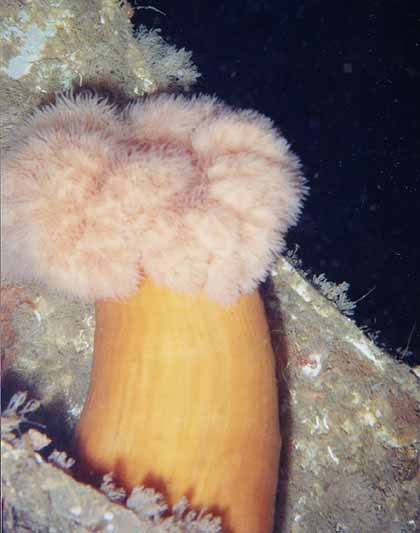
There had been weather last week, so I wasn't sure how conditions would be. Often, I was just not that lucky when it came to conditions in San Diego. Too often I got rough days with poor vis. Of course, I usually seem to go the worst time of the year. Not this trip though. It is getting into the best time of year for local diving. I figured that this could be some good fair weather diving today or crummy from lingering storm crud.
The plan was a dive on the Yukon, then the Ruby E and then a tank in the kelp. All I needed was some reasonable cooperation from the sea. Unfortunately, as we all know, the sea is more moody than reasonable.
Being on the Lois Ann, I planned all my dives to be on the 32% NITROX that their compressor provided.
It was calm as we left the harbor. It was also quite overcast, but that would probably turn into Southern California Sunny a bit later on. After about a 15 minute ride, we tied up at the Yukon. There was only one other boat there.
Captain Wood did most of the dive briefing, saying that we were tied up at the stern, racheda , racheda, racheda. As I did final preparations, a look around at the other divers showed just about as much variation in person and diving as could be put on one boat. Divers came from near and far, were young and old as well as beginners and old salts.
On my last, recent trip to the Yukon, the conditions had been good, so I had gotten to do a fairly good exploration of some of the ship. It was the first time I had had good enough visibility look across the deck and see just how big that ship is. Sure, it's 366 feet long, but I can't see much of that. Looking down and seeing across the entire deck of the ship, shows something of how big it is. I wanted to see more of it.
I hopped in and swam to the mooring we were tied to. After looking down, I called back to the boat that the vis looked really good. I came down on the stern and checked out the huge propeller hubs before going in the nearest hole in the side of the hull. This was the highest part of the wreck where I had gone before and it looked a bit familiar. This time I worked down though instead of forward. My procedure was to move to the entrance to the next compartment, but before entering it, I would make sure to see where the nearest hole through the hull was. If somehow, I don't know how, the compartment got silted, I could always go out that.
It was really fun. I intentionally went routes that I knew I had not gone before. I went down one of the dark wells that was a corridor from one side of the wreck to the other so that I was on the port side that was resting on the sand. On this side is the long corridor that goes most of the length of the ship. Everywhere were the beautiful white Metridium Anemones. There were a number of fish in the wreck as well, mostly Sand Bass, but a few other species too. The vis in the wreck was great. I think I was the first person in there that day. I would go from compartment to compartment. The holes in the hull to the outside of the ship were like bright glowing panels, but the rest is dark. I think it is more fun with the smaller light I was using because you have to really look around with it to see the compartments and what is in them. You usually also have to look around a bit for the way to the next compartment. Like last time, I wasn't seeing much in the way of artifacts aside from the hull. There were pipes, wiring and the occasional electrical panel, but not much else. Then I found the big hole that went from near the top deck to near the bottom of the ship. I followed that down. It's big enough that my light disappeared in it. From there I went into a compartment and found the electrical distribution center of the ship. It was filled with normal power distribution panels and a large section of breadboard electrical control panels. It all seemed in good condition. That was cool and I took some pictures in there.

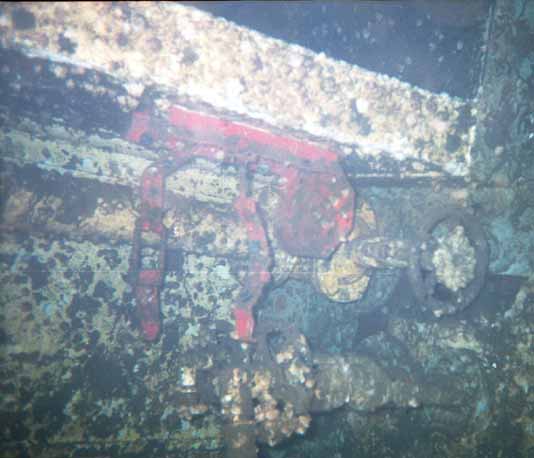

Around here, the passages between compartments made more turns and had to be looked for. Then, very cool, I went into a room with giant gears. This was the propeller drive room. It seemed like the large tube at the back was the propeller shaft, but I couldn't say for certain. There were a couple of gears about 8 inches wide and perhaps 2 feet in diameter, but most interesting was the gear that was about 6 feet across. I had to work to get in a position where my camera might get a picture of it.
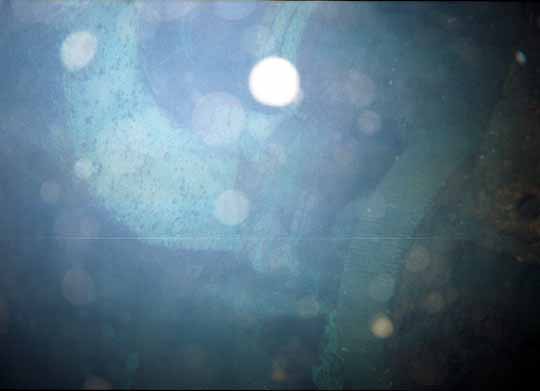
As I went into the next compartment, I saw a cave line. I have no idea who was on the end of that or where they presently were.
I continued on until I was near the bow of the ship. The compartments on the
lower part of the ship, the port side, are generally larger than the
compartments on the starboard, higher side. It seemed like there was more silt
buildup in the lower compartments, but that was no surprise.
Since silt, or the blackout caused by disturbed silt, is considered one of the
primary hazards of wreck diving, I was curious about how much of an issue it
was likely to be in this ship. I entered a deeper compartment near the bottom
and gave two hard kicks into the silt. There was very little result and
certainly not anything like silt outs I've seen before. It was just some crud
stirred up. Later, Captain Wood told me that the silt is finer in the rooms
with more pipes and wiring. I could see one day a project to pump mud out of
the lower parts of the ship.
I had sort of run out of ship by now and it was time to move up a bit anyway. I came out under the superstructure. There were a number of divers moving 'over' the deck. I was taking pictures and looking at small deck features to see if I could find some of the cleaner shrimp I had seen last trip. Again, the Metridiums offered fantastic photographic subjects. There were a lot of perch all over the deck as well. With good visibility, it was great looking across the deck.
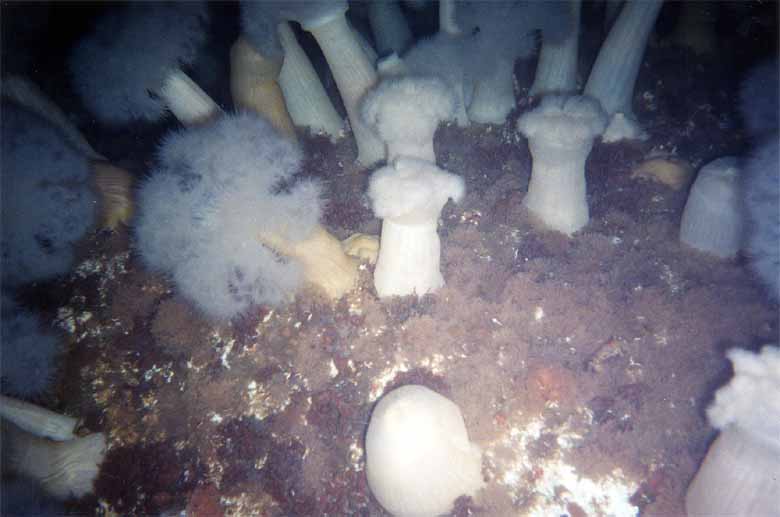
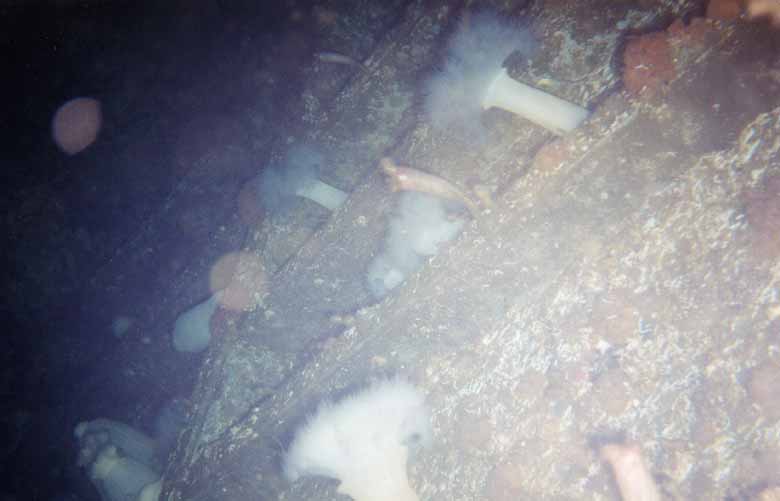
It was that time. I went to the stern and headed up the mooring line. It sure is an easy way to make an ascent. All in all, easy is a good description of the Yukon wreck. Most natural wrecks have multiple hazards of depth, entanglement, silt out, getting lost and other things. I have to compliment all of the people that went to so much work to make this wreck so diver friendly and safe. True, you won't find much in the way of artifacts, but you can have a great, fun dive and it is only going to get better as the years pass and the sealife grows in even more. Everyone that came up had had a real good experience.
Snacks and hot chocolate were provided for the short trip to the Ruby E.
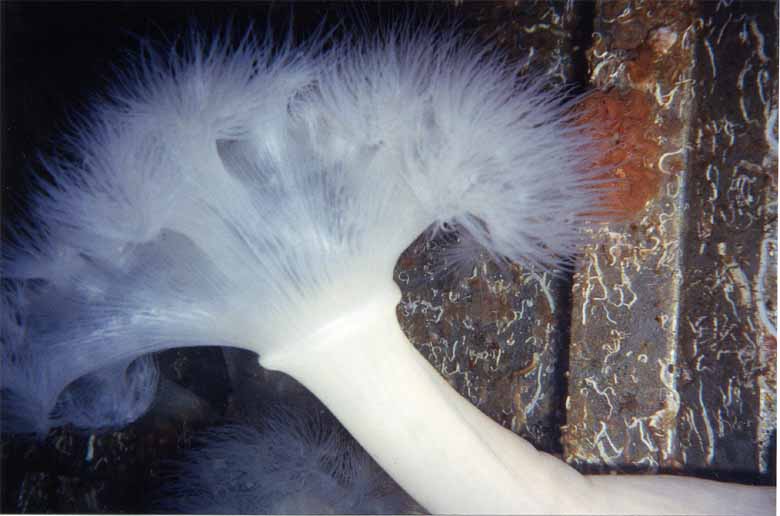
Enjoy the diving, seahunt